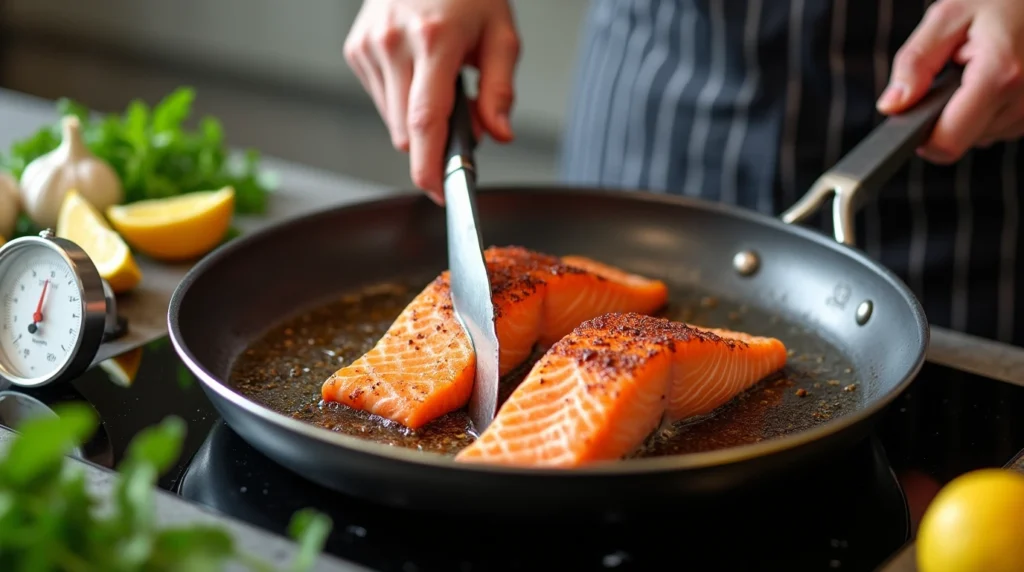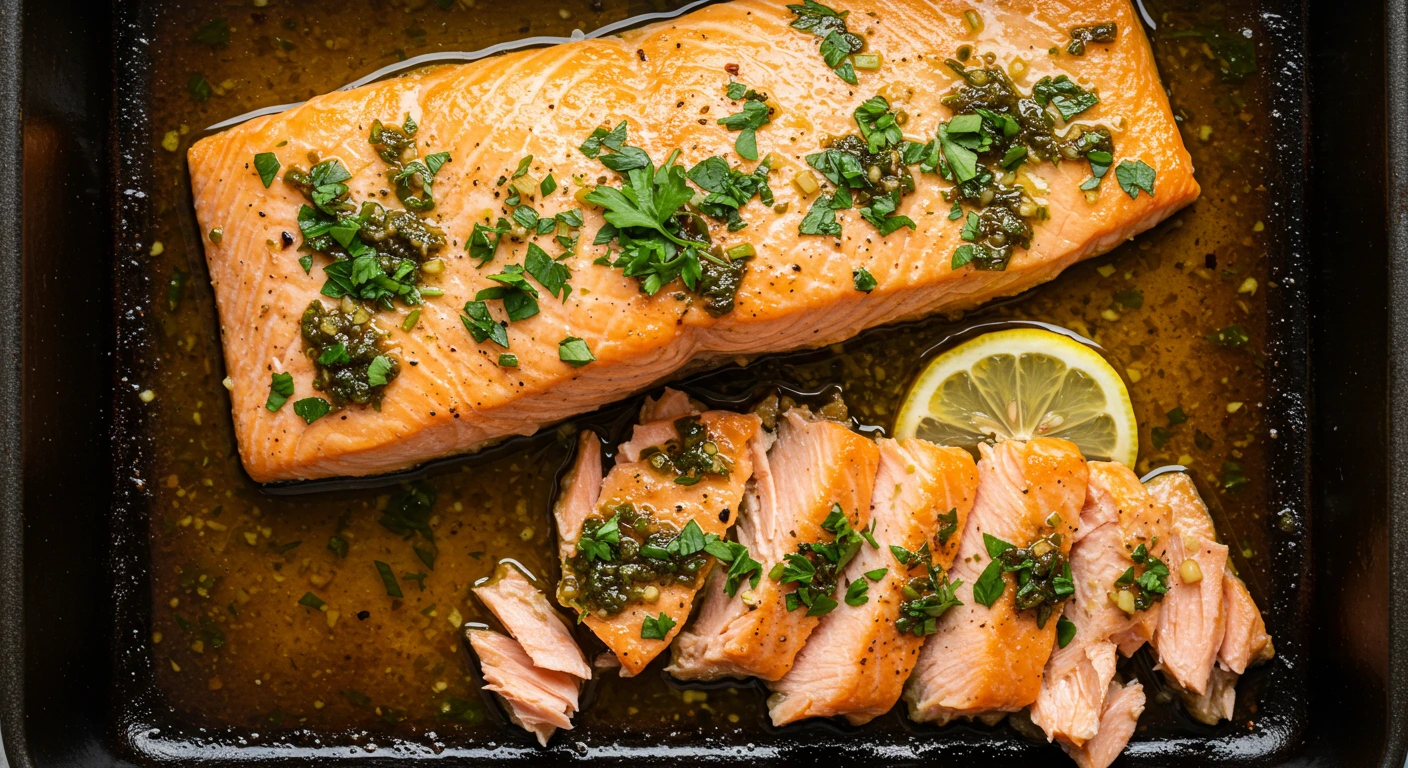There’s something undeniably satisfying about cooking fish perfectly. Whether it’s flaky white fish, tender salmon, or succulent tuna, getting the texture just right can transform a simple meal into something extraordinary. But, achieving that perfect texture isn’t as straightforward as just cooking it until it looks done. You need to know the right fish cooking temperature.
When you cook fish to the ideal temperature, you unlock the best texture and flavor. Overcook it, and it becomes dry and tough; undercook it, and you risk food safety issues. Understanding how to cook fish to the right temperature is crucial for ensuring that your meals are both delicious and safe to eat. This guide will walk you through the essentials of fish cooking temperature, from the perfect range for different types of fish to tips on achieving flawless results every time.
Table of Contents
Understanding Fish Cooking Temperature: Why It Matters
The Science Behind Cooking Fish
Cooking fish at the right temperature isn’t just about taste; it’s about texture, moisture retention, and food safety. Fish proteins, particularly in delicate fish like cod or tilapia, can break down at high temperatures, making them dry and chewy. However, cooking them at too low of a temperature can leave them undercooked, resulting in a mushy texture or an unpleasant, raw center.
The key is finding that perfect balance. The ideal fish cooking temperature ensures that the fish reaches a safe internal temperature while preserving its natural moisture, leaving it flaky and tender. This is why using a food thermometer is crucial—this ensures precision in cooking and helps avoid common mistakes.
Fish Cooking Temperatures and Food Safety
The U.S. Food and Drug Administration (FDA) recommends cooking fish to an internal temperature of 145°F (63°C) for safety. At this temperature, fish is fully cooked and safe to eat, while maintaining its ideal texture. This standard applies to most types of fish, including salmon, cod, and tilapia. However, some fish may have specific recommendations depending on their thickness or preparation method.
The Ideal Fish Cooking Temperature: A Step-by-Step Guide
Recommended Internal Temperatures for Different Types of Fish
Not all fish are the same, and different types require different cooking temperatures. While the general recommendation is 145°F, some fish, particularly fatty ones like salmon or tuna, may benefit from a slightly lower cooking temperature to preserve their natural texture.
Fish Temperature Chart
| Fish Type | Recommended Cooking Temperature (°F) | Texture Characteristics |
|---|---|---|
| Salmon | 125°F to 130°F (Medium) | Flaky, moist, tender |
| Tuna | 120°F to 130°F (Medium Rare) | Tender, slightly rare |
| Cod | 145°F | Firm, flaky |
| Halibut | 130°F to 140°F | Flaky, moist |
| Tilapia | 145°F | Tender, moist |
| Trout | 145°F | Moist, flaky |
As you can see, fatty fish like salmon and tuna can be cooked to a slightly lower temperature, allowing them to retain their natural oils and moisture. Leaner fish like cod and tilapia, on the other hand, benefit from a higher cooking temperature to ensure they don’t dry out.

Using a Meat Thermometer for Precision
One of the best ways to achieve the perfect fish texture is by using a food thermometer. It’s the most accurate way to ensure your fish is cooked to the right temperature, especially when you’re cooking thick cuts or unfamiliar fish.
Here’s how to use a thermometer properly:
- Step 1: Insert the thermometer into the thickest part of the fish, making sure it doesn’t touch the bone or the pan.
- Step 2: Wait a few seconds for the thermometer to register the temperature.
- Step 3: Once it reaches the recommended temperature (145°F for most fish), remove the fish from heat.
Using a thermometer ensures you get the perfect texture every time, without the guesswork. If you don’t have a thermometer, you can also rely on visual cues, but a thermometer provides the most reliable results.
Different Cooking Methods and Their Impact on Fish Texture
Grilling, Baking, Pan-Seared, and Poaching: How to Adjust Temperatures
The method you choose for cooking your fish will also affect its texture. Each cooking technique has its own benefits, and knowing how to adjust temperatures based on your method is key to achieving perfect fish.
Grilling Fish
Grilling adds a wonderful smoky flavor and crispy exterior to fish, especially fattier fish like salmon. For grilling, you’ll want to use medium-high heat (375°F) and cook the fish for about 3-5 minutes per side depending on thickness.
- Pro Tip: Use a grill-safe thermometer to check the internal temperature without removing the fish from the grill.
Baking Fish
Baking is a simple and hands-off method that works well for a variety of fish. Preheat your oven to 375°F, and bake the fish for 10-15 minutes, depending on thickness. You’ll know the fish is done when it reaches 145°F internally and flakes easily with a fork.
- Pro Tip: Cover the fish with foil to retain moisture, or drizzle with olive oil or butter to keep it juicy.
Pan-Seared Fish
Pan-searing is perfect for getting a crispy exterior while keeping the inside moist. For this method, use medium-high heat and cook the fish for about 2-3 minutes per side.
- Pro Tip: Don’t overcrowd the pan—this ensures even cooking and prevents steaming.
Poaching Fish
Poaching is a gentle cooking method that involves simmering fish in a liquid (like water, broth, or wine) at a temperature between 160°F to 180°F. This is a great method for delicate fish like trout and flounder.
- Pro Tip: Use a lid to cover the pan and retain heat while poaching. Poaching is ideal for preserving the moisture and texture of fish.

Signs Your Fish Is Perfectly Cooked
Sometimes, even with a thermometer, it can be helpful to know other ways to check if your fish is perfectly cooked. Here are a few signs to look for:
- Flaking: When you insert a fork into the fish, it should easily flake into large, tender pieces.
- Opacity: The flesh should be opaque, not translucent. This is a sign that the fish has been fully cooked.
- Firmness: Fish should feel firm to the touch but not tough. It should give a little when pressed but still retain its structure.
If your fish is cooked properly, it should melt in your mouth and be tender, not dry or tough.
Tips for Achieving the Perfect Fish Texture Every Time
How to Avoid Overcooking or Undercooking Fish
Overcooking fish is a common mistake, but it’s easy to avoid once you understand how temperature works. To prevent overcooking:
- Use a thermometer: This is the best way to avoid the uncertainty of visual cues.
- Rest your fish: Once it’s cooked, let the fish rest for a few minutes. This allows the juices to redistribute and helps prevent the fish from drying out.
- Don’t cook it for too long: Fish cooks quickly, so be mindful of the cooking time, especially for thinner fillets.
The Importance of Fish Freshness
The fresher your fish, the better the texture. Fresh fish have a natural, firm texture that becomes soft and flaky when cooked correctly. Look for fish with clear eyes, firm flesh, and a clean, ocean-fresh scent. When fish isn’t fresh, it can become mushy and lose its delicate texture, no matter how well you cook it.
Common Fish Cooking Mistakes to Avoid
Even experienced cooks can make mistakes when preparing fish. Here are some common errors to watch out for:
- Overcooking: Fish cooks quickly, and it’s easy to leave it on the heat for too long. Use a thermometer to prevent this.
- Using high heat for delicate fish: Fish like tilapia or flounder should be cooked over lower heat to avoid toughening the flesh.
- Cooking from frozen without a plan: While cooking frozen fish is possible, it requires extra care. Always thaw your fish before cooking, or follow specific methods for cooking from frozen.
Conclusion: Mastering the Perfect Fish Cooking Temperature
Achieving the perfect fish texture is all about understanding the right cooking temperature. Whether you’re grilling, baking, pan-searing, or poaching, knowing the ideal temperature for different types of fish ensures that you’ll have a moist, flaky result every time. Armed with the knowledge of fish cooking temperatures and techniques, you’ll never have to worry about overcooking or undercooking again.
Call to Action
Ready to master the art of cooking fish? Next time you’re in the kitchen, keep these tips in mind and use a thermometer to get your fish to the perfect temperature. Whether you’re cooking for a family dinner or impressing guests with your culinary skills, the right cooking temperature will elevate your fish dishes to a whole new level of flavor and texture. Happy cooking!
FAQ: Fish Cooking Temperature
What temperature should fish be cooked to for safety?
Fish should be cooked to an internal temperature of 145°F (63°C) for safety. This ensures it’s fully cooked and safe to eat.
Can you cook fish at a lower temperature for a more tender texture?
Yes, cooking fish at a slightly lower temperature (e.g., 120°F to 130°F) can help preserve its natural moisture and give it a tender texture, especially for fatty fish like salmon.
How can I tell if my fish is cooked without a thermometer?
Fish is cooked when it flakes easily with a fork, turns opaque, and feels firm but not tough.
Can I cook frozen fish?
Yes, but it’s best to thaw the fish before cooking. If cooking from frozen, adjust the cooking time and follow specific guidelines for best results.
What do you think of these recipes?
There are no reviews yet. Be the first one to write one.













